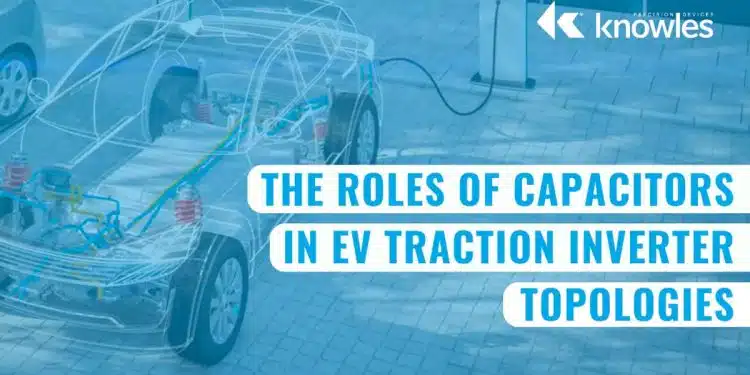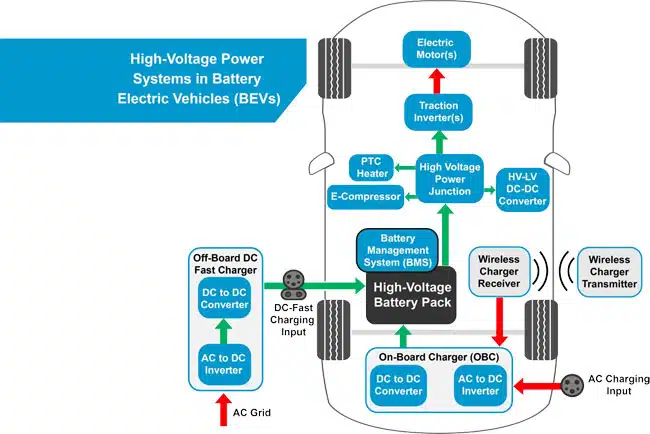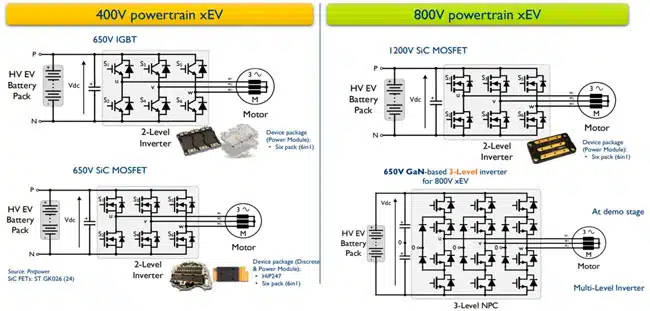This article based on Knowles Precision Devices blog explains role of capacitors in EV inverters.
The power electronic systems in an electric vehicle (EV) feature a wide variety of capacitors.
From DC-link capacitors to safety capacitors and snubber capacitors, these components play a critical role in stabilizing and safeguarding the electronics from factors like voltage spikes and electromagnetic interference (EMI).
Here, we’ll focus on the capacitors used in the EV traction inverter.
Traction inverters are a critical power electronic device in EVs. They convert direct current (DC) from the vehicle’s batteries into alternating current (AC) to power the electric motor that drives the vehicle.
Before making any decision on what capacitors you need, you must first decide which traction inverter topology is right for your specific application.
There are four main topologies of traction inverters, with differences based on type of switch, voltage and levels. Choosing the appropriate topology and related components is critical in designing traction inverters that meet your application’s efficiency and cost requirements.
Types of Traction Inverter Topologies for Electric Vehicles
As stated, there are four most used topologies in EV traction inverters, as shown in Figure 2.:
- 2-Level Topology featuring the 650V IGBT switch
- 2-Level Topology featuring the 650V SiC MOSFET switch
- 2-Level Topology featuring the 1200V SiC MOSFET switch
- 3-Level Topology featuring the 650V GaN Switch
These topologies fall into two subsets: 400V Powertrains & 800V Powertrains. Between the two subsets, it’s more common to use the “2-level” topologies. “Multi-level” topologies are used in higher voltage systems such as electric trains, tramways and ships but they are less popular due to higher cost and complexity.
The Role of Capacitors in EV Traction Inverter Application
There are many different types of capacitors that ensure the efficient and effective operation of your traction inverter. Here are the main players:
- Snubber Capacitors – Voltage suppression is important to protect circuits from large voltage spikes. Snubber capacitors connect to the high-current switching node to protect electronics from voltage spikes.
- X & Y Safety Capacitors – Safety capacitors mitigate the effects of transient voltages and interference in electrical and electronic circuits, especially in high-voltage applications. There are two classes of capacitors, Class-X and Class-Y, that are both used to minimize EMI in different applications.
- Bypass Capacitors – All electronics depend on clean power, and bypass capacitors are crucial for ensuring devices safely meet their power specifications. These capacitors act as filters, bypassing high-frequency noise.
- Decoupling Capacitors – In power supplies, decoupling capacitors are placed near sensitive components to suppress voltage fluctuations or noise on power supply lines.
- DC-Link Capacitors – In EV applications, DC-link capacitors help offset the effects of inductance in inverters. They also serve as filters that protect EV subsystems from voltage spikes, surges and EMI.
- DC-Link Supporting Filters – Smoothing ripples, storing energy and suppressing surges are critical functions of DC-link supporting filters.
- Flying Capacitors – EVs needs lightweight, compact components. Flying capacitors can balance out voltage and extend the longevity of components.
All of these roles are very important to the safety and functionality of traction inverters, but the design and specifications of these capacitors change based on which traction inverter topology you choose.




































